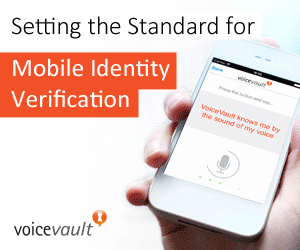It’s week three of Voice Month here at FindBiometrics in which we are exploring the world of hands free authentication through our featured articles and upcoming webinar. If you’ve read our previous featured articles on voice biometrics, you will have likely come to the conclusion that the modality of the month is nothing if not versatile. In our primer we saw an overview of the many uses for voice biometrics and last week, in the article “The Place For Voiceprints”, we examined the technology’s aptitude for serving to specialized niches. This week it’s time to take a look at some real applications of voice biometrics in order to demonstrate its versatility in the field.
-
Targeting the Developers
 One of the great benefits of choosing voice biometrics is its accessibility and VoiceVault’s ViGo solution represents this idea perfectly. Initially targetted at the financial markets, the cloud based software solution, available on a licensing basis, has branched out to target mobile developers of all kinds. After all, why pigeonhole yourself when there are so many areas of application for voice biometrics?
One of the great benefits of choosing voice biometrics is its accessibility and VoiceVault’s ViGo solution represents this idea perfectly. Initially targetted at the financial markets, the cloud based software solution, available on a licensing basis, has branched out to target mobile developers of all kinds. After all, why pigeonhole yourself when there are so many areas of application for voice biometrics?
Because of its software based nature, ViGo can be adopted by developers looking for a convenient and secure way to protect in-app payments, transform a phone into a biometric credential and aid clinicians in the difficult to enter healthcare markets. When you target developers rather than specific markets, voice biometrics can call any connected device with a microphone home.
-
Hands Free Interface
 The advent of connected cars and the Internet of Things is upon us and while that means we’re on the cusp of unprecedented automation and convenience, experts have been quick to point out the security vulnerabilities presented by such an increase in connectivity. That’s where voice biometrics comes in. Voice recognition, combined with speech commands, can allow for interfacing with connected devices and vehicles while at the same time offering biometric levels of identification.
The advent of connected cars and the Internet of Things is upon us and while that means we’re on the cusp of unprecedented automation and convenience, experts have been quick to point out the security vulnerabilities presented by such an increase in connectivity. That’s where voice biometrics comes in. Voice recognition, combined with speech commands, can allow for interfacing with connected devices and vehicles while at the same time offering biometric levels of identification.
Soon, the best place to find an example of said technology will be the sky. Recently Honeywell announced that it is working with pilots to develop a voice recognition powered hands free system for airplanes. With multiple voices and a high level of noise in the cockpit, it is essential that a hands free control can tell the difference between speakers. Once the details are hammered out, pilots can expect a much easier time in the sky.
-
Call Center Authentication
 Proving your identity over the phone is no easy task, that is unless a voiceprint biometric system is in place to allow for strong authentication. The days of having to answer security questions and enter PINs when on the phone with a customer service agent are nearly over thanks to software solutions like SpeechPro’s VoiceKey, which was recently included on Aspect Software’s Innovation Exchange marketplace.
Proving your identity over the phone is no easy task, that is unless a voiceprint biometric system is in place to allow for strong authentication. The days of having to answer security questions and enter PINs when on the phone with a customer service agent are nearly over thanks to software solutions like SpeechPro’s VoiceKey, which was recently included on Aspect Software’s Innovation Exchange marketplace.
The benefits offered by VoiceKey and solutions like it stretch beyond cutting down on fraud. Anyone who’s ever been on either side of a call center transaction knows that convenience is key to a positive customer experience. With the easy assurance of a voiceprint authentication system call times go down and satisfaction skyrockets.
-
Proof of Life
 In a similar vein, voice biometrics are actively cutting down on fraud around the globe. Sometimes identity assurance trumps convenience, but why compromise when you can have both? In South Africa, AGNITiO’s Voice iD is accurately identifying grant beneficiaries over the phone in one of the largest voice recognition deployments in the world (the solution has been rolled out to 10 million beneficiaries).
In a similar vein, voice biometrics are actively cutting down on fraud around the globe. Sometimes identity assurance trumps convenience, but why compromise when you can have both? In South Africa, AGNITiO’s Voice iD is accurately identifying grant beneficiaries over the phone in one of the largest voice recognition deployments in the world (the solution has been rolled out to 10 million beneficiaries).
Called the Proof of Life system, the biometric deployment is a combination of AGNITiO’s Voice iD engine and Net1’s electronic grant distribution system. Combining government issued debit cards with accurate voice biometrics is helping make sure that money goes where it’s supposed to while also streamlining operations.
-
Multi-Factor Logical Access Control
 As we saw last week, one of the particular niches voice biometrics can serve is the multi-factor authentication market, especially when it comes to consumer mobile deployments. Having two factors protecting critical data greatly increases security, and accurate voice recognition makes sure things stay nice and frictionless.
As we saw last week, one of the particular niches voice biometrics can serve is the multi-factor authentication market, especially when it comes to consumer mobile deployments. Having two factors protecting critical data greatly increases security, and accurate voice recognition makes sure things stay nice and frictionless.
One of the more common ways we are currently seeing voice recognition bolster mobile security is in combination with face biometrics. The two contactless modalities are especially well suited for each other as they simply require the standard front facing camera and microphone on a mobile device to work properly. Consumers can benefit from multi-factor biometric authentication without having to spring for a flagship smartphone that has an embedded fingerprint sensor.
Right now two great examples of this kind of multi-factor solution can be found and downloaded right now. The USAA mobile banking app recently upgraded to allow for customers to use face and voice recognition as a way to access their accounts, while new software from Sensory called AppLock (available for free in Google Play) lets you choose which apps and functions on your phone are most important and scale the authentication appropriately. The latter of the solutions is rather tailored toward becoming increasingly convenient as it features intelligent software that allows a user’s phone to become more familiar with her face and voice after every use.
*
Stay posted to FindBiometrics throughout February as we dig deeper into the world of voice biometrics. Be a part of the conversation by following us on Twitter and using the hashtag #FBVoiceMonth.
Don’t forget to sign up for our upcoming Voice Month webinar: Voice Biometrics in a Multi-Modal Future.
Voice Month at FindBiometrics is made possible thanks to our sponsors: AGNITiO, VoiceVault and SpeechPro USA.
—
February 18, 2015 – by Peter B. Counter


Follow Us